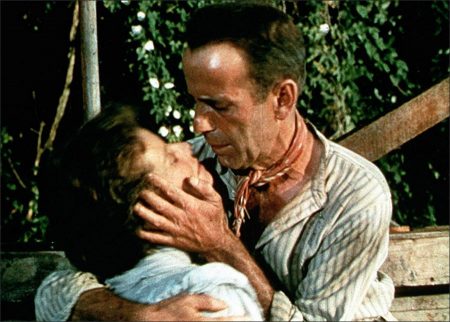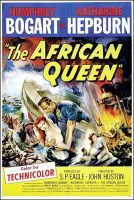Tagline: The greatest adventure a man ever lived…with a woman!
The African Queen movie storyline. 1914 in German East Africa. Brother and sister, Reverend Samuel and Miss Rose Sayer, are British Christian missionaries. They are reliant upon Canadian Charlie Allnut, who owns and operates a run-down river boat called the African Queen, for mail and supplies, Charlie who works as a mechanic at a mine one day away along the river.
The Sayers merely tolerate Charlie, who they consider a little too rough around the edges for their proper British and Christian sensibilities. They consider his heavy drinking especially problematic. The Sayers only hear about the war raging in Europe from Charlie, not experiencing any of it until the Germans later raid their village, the Germans believing it the best way to control the natives and co-opt them into military service. Reverend Sayer passes away from the shock experienced by watching what the Germans did. As such, Charlie has to help Rose escape from the ravaged missionary compound before the Germans return.
They not only have to beware the Germans, who Charlie knows they have to pass along the only route along the river, but deal with dangers of the river, such as the rapids, and their own differences, especially being in such tight quarters on a 30 foot boat. Those differences are heightened when Charlie would rather wait their time out somewhere secluded along the river, while Rose suggests they torpedo a German gunboat along the way. But all these issues in combination make for strange bedfellows, the two who are dependent upon each other for both their physical and emotional well being.
The African Queen (1951) is the uncomplicated tale of two companions with mismatched, “opposites attract” personalities who develop an implausible love affair as they travel together downriver in Africa around the start of World War I. This quixotic film by director John Huston, based on the 1935 novel of the same name by C. S. Forester, is one of the classics of Hollywood adventure filmmaking, with comedy and romance besides. It was the first color film for the two leads and for director Huston.
The acting of the two principal actors – Humphrey Bogart and Katharine Hepburn – is some of the strongest ever registered on film, although this was their first and only pairing together. They portray an unshaven, drinking and smoking captain of a cranky tramp steamer, and a prissy and proper, but imperious and unorthodox WWI-era African missionary spinster. [This was 44 year-old Hepburn’s first screen appearance as a spinster, and marked her transition to more mature roles for the rest of her career. At 52 years of age, Bogart was also past his prime as a handsome, hard-boiled detective.] John Mills, David Niven, and Bette Davis were, at one time, considered for the lead roles.
Directed on location (on the Ruiki in the then Belgian Congo and the British protectorate of Uganda) by John Huston (it was his ninth feature film and fifth film with Bogart), the film was nominated for four Academy Awards – Best Actress (Katharine Hepburn), Best Screenplay (James Agee and John Huston), Best Director, and Best Actor (Humphrey Bogart). Bogart was the only one to win – the film’s sole Oscar. In hindsight, Bogart’s award (his sole career Oscar) was probably consolation for the oversight he experienced three years earlier when he wasn’t even nominated for one of his best roles as Fred C. Dobbs in Huston’s The Treasure of the Sierra Madre (1948).
The African Queen (1951)
Directed by: John Huston
Starring: Humphrey Bogart, Katharine Hepburn, Robert Morley, Peter Bull, Theodore Bikel, Walter Gotell, Peter Swanwick, Richard Marner, John von Kotze, Gerald Onn, Errol John
Screenplay by: James Agee
Cinematography by: Jack Cardiff
Film Editing by: Ralph Kemplen
Art Direction by: Wilfred Shingleton
Makeup Department: Eileen Bates, George Frost
Music by: Allan Gray
MPAA Rating: PG for thematic elements, some violence and smoking.
Distributed by: United Artists
Release Date: December 23, 1951
Views: 202

